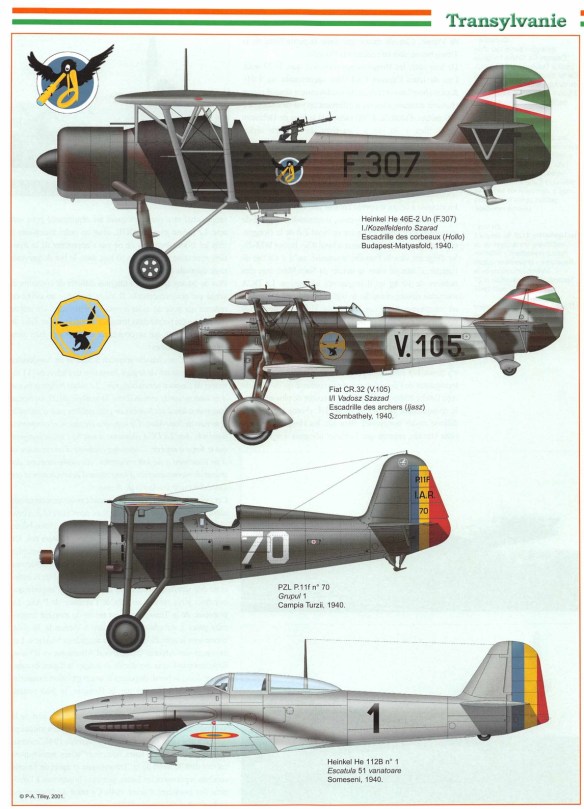Hungarian-Romanian War [alterative history]
The Hungarian-Romanian War (Hungarian: Magyar–román háború, Romanian: Razboiul romano-maghiar), was a military conflict fought between the Kingdom of Romania and Kingdom of Hungary between March 1, 1918 and June 15, 1920 over the disputed territory of Transylvania, which was ceded to Hungary in the Vienna Awards in 1940.
The Soviet ultimatum to Romania in June 1940 demanding the return of Bessarabia and northern Bukovina set things in motion in the whole of south-eastern Europe. Because Romania was an important supplier of oil to Germany, Hungary’s ever-increasing pressure on it—which, incidentally, had terminated its Mutual Assistance Pact with Britain and France—threatened German interests. The danger of Soviet intervention if armed conflict arose between Romania and Hungary gave the final impetus for the Second Vienna Award. Read More
After unsuccessful bilateral negotiations. Ribbentrop and Ciano decided on 30 August 1940 that Romania had to cede to Hungary northern Transylvania with its mainly Magyar and Székely-inhabited districts, a total of 43,103 square km. with 2,577,000 inhabitants, of whom at least two-fifths (according to Romanian data, almost half) were Romanian. At the same time over 400,000 Magyars remained in southern Transylvania. The Romanians regarded the Second Vienna Award as a national catastrophe, and staked everything on being able to reclaim the territories in the course of the war through exemplary devotion to Hitler. (The Führer met General Antonescu, the Romanian head of state, twenty times during the war. He had only four meetings with Horthy.)
The Hungarians’ jubilation knew no bounds. The seventy-two-year-old Regent entered Kolozsvár (Cluj) at the head of the Hungarian army on 15 September 1940, once again riding a white stallion. However, Hungarian opinion was far from satisfied; it wished to see southern Transylvania regained as well, but Hitler prevented any military action by Hungary. He observed to Count Ciano on the morning of 28 August 1940 at the Berghof that Hungary should acquiesce in any compromise, since its revisionary successes were entirely due to Fascism and National Socialism.
Hungarian soldiers were cheered wherever they went by the populace, who had had to live for two decades separated from their nation and homeland and who had mostly been exposed to open discrimination. It should not be forgotten that it was only after the Second Vienna Award that Britain and the United States registered their protests, or rather questioned the award’s validity. Diplomatic relations were severed after the attack on Yugoslavia. The political and cultural élite of the country regarded the series of territorial gains achieved without a war with an undiluted “sense of achievement”. The public did not take into account international repercussions, let alone the high price that Hitler would demand in return. This high price included recognition of the Berlin-controlled German Volksbund in Hungary and the extended rights of the German minority, laid down in a special agreement with the German Reich. Of the 720,000 German-speaking inhabitants 533,000 declared themselves as German nationals in the census of 1941. The Waffen-SS was given the right to recruit German volunteers in Hungary.
King Carol, whose weak position was threatened not only by the loss of national territory but also by the hostility of the fascist Iron Guard (whose temper had not been improved by the murder in 1938 of its leader Corneliu Codreanu), tried to save himself by inviting the army leader Marshal Ion Antonescu and the Iron Guard to join his government, but they were advised by Germany not to. The loss of more territory by the second Vienna Award and the Treaty of Craiova (by which Hitler allotted parts of Rumania to Hungary and Bulgaria) made Carol’s position impossible and he abdicated. Antonescu, a stupid rather than a sinister man, with a pushing wife, joined the government of the new King Michael and so too did the Iron Guard, but the mutual antipathy of the army and the Iron Guard produced a threat of civil war. The Iron Guard attempted a coup but Hitler, who wanted no trouble in Rumania and who had formed a favourable impression of Antonescu in the course of two visits by the Marshal to the Führer, decided to back the army which, with the help of German tanks, smashed the Iron Guard. Its leaders were lodged in internment camps until 1944 when, Antonescu having been overthrown by the tides of war, they were extracted to form a phantom Rumanian government in Vienna.
